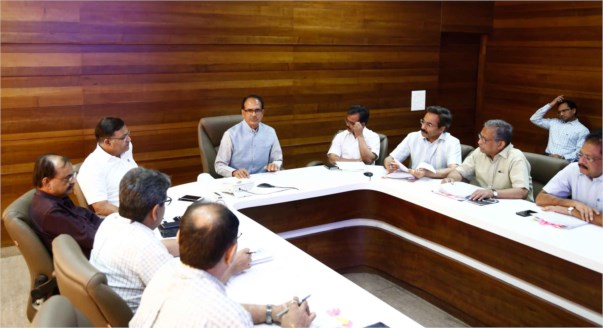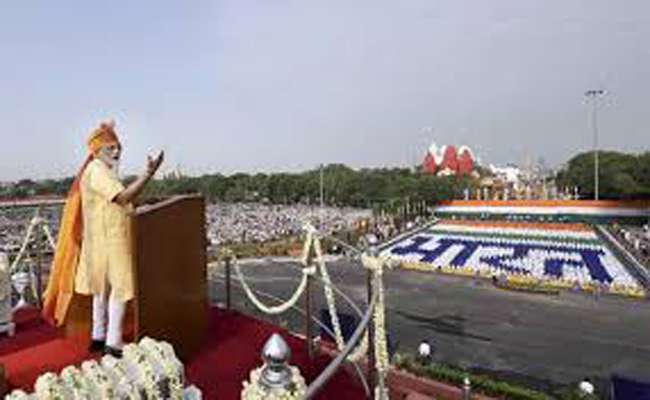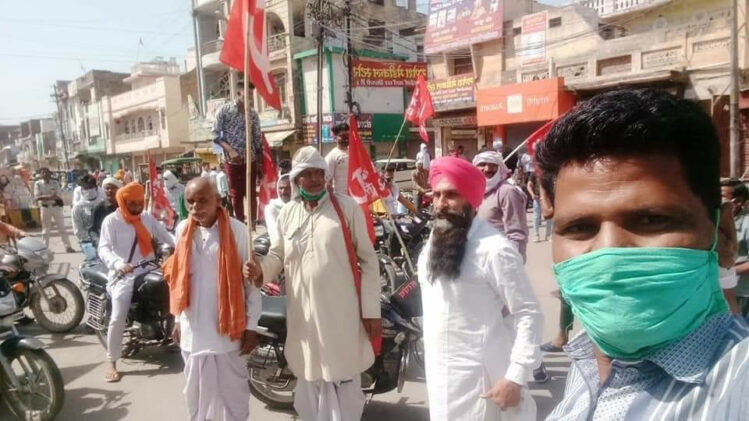दो कहानियाँ और मुख्यधारा की मीडिया के दो अलग-अलग मापदंड
वाह रे मीडिया! आप ज्योति मौर्य को भी इसकी अनुमति नहीं देते। आप उसके पति को सलाह नहीं दे रहे हैं कि वह अपनी पूर्व पत्नी को अपने दम पर जीवन जीने की अनुमति दे क्योंकि उनकी शादी विफल हो गई है। लेकिन आप चाहते हैं कि गुलाम हैदर किसी अन्य व्यक्ति के लिए सीमा के प्यार को स्वीकार करे

दोनों कहानियों में, महिला या तो ‘खलनायक’ है या ‘नायिका’, यह इस बात पर निर्भर करता है कि उसने क्या किया है मतलब यह कि कहानी में मसाला है या नहीं उसके लिए एक पात्र के इस्लाम से संबंध होना ज़रूरी है और भारतीय इलेक्ट्रॉनिक मीडिया के पूर्ण अपराधीकरण या सांप्रदायिकरण को दर्शाता है। एक कहानी ज्योति मौर्य नाम की महिला की है, जो अब उत्तर प्रदेश सरकार में एक अधिकारी हैं। उनके बारे में कहानी यह है कि उनकी शादी एक ऐसे व्यक्ति से हुई थी जो अपनी शादी के समय एक अधिकारी होने का दिखावा करता था लेकिन वास्तव में एक ‘सफाई कर्मचारी’ था।
आम तौर पर, इस तरह के झूठ और धोखे हमारी ‘मूल्य प्रणाली’ का हिस्सा हैं, जब भी हम किसी ‘लड़की’ या लड़के की तलाश करते हैं तो हम कहानियां गढ़ते हैं ताकि समाज में इज़्ज़त बनी रहे जो हमारे रुतबे से आती हैं. फिर उसके लिए हम झूठ का ताना बना बुनते हैं और फिर एक प्राथमिक शिक्षक ‘प्रोफेसर’ बन जाता है या एक प्रयोगशाला सहायक डॉक्टर बन जाता है। जो लोग बिना नौकरी के भी शादी कर लेते हैं, उनमें से कई को अच्छा ‘दहेज’ मिलता है, सिर्फ इसलिए क्योंकि उनके माता-पिता दावा करते हैं कि वे ‘सिविल सेवाओं’ के लिए ‘तैयारी’ कर रहे हैं। हालाँकि उनमें से अधिकांश कभी भी इसके लिए योग्य नहीं होते हैं, लेकिन हाँ उन्हें ‘अच्छी दुल्हन’ और दहेज दोनों मिलता है। ये है ‘काऊ बेल्ट’ की हकीकत. ज्योति मौर्य सबसे बड़ी ‘खलनायक’ बन गईं क्योंकि उन्होंने वैवाहिक विवाद के कारण अपने पति को छोड़ दिया था।
भारत में मीडिया ने यह कहानी फैलाई थी कि उन्होंने अपने पति को इसलिए छोड़ दिया था क्योंकि वह ‘सफाई कर्मचारी’ थे।
यहां आपको यह भी बता दूं कि सफाई कर्मचारी उत्तर भारत में मुख्य रूप से दलितों या वाल्मिकी, रावत या हेला समुदाय द्वारा की जाने वाली नौकरी थी, लेकिन कुछ साल पहले जब उत्तर प्रदेश सरकार ने पंचायत स्तर पर कुछ स्थायी नौकरियां निकालीं। सफाई कर्मचारियों का वेतन उन मूल मजदूरों की तुलना में कहीं बेहतर था जो सीवेज लाइन में काम करते हैं या नगर पालिकाओं के साथ काम करते हैं क्योंकि उनमें से अधिकांश दैनिक वेतन भोगी कर्मचारी हैं। विडंबना यह है कि पंचायत सफाई कर्मचारी जो शायद ही कभी सफाई या सफ़ाई का काम करते हैं, उनके लिए अन्य समुदायों के अधिकांश लोग नौकरी में आ गए। यह ध्यान रखना दिलचस्प होगा कि उन्हें दी गई नियुक्तियों की सटीक संख्या और बहुमत या तो ओबीसी या सवर्णों में से होगा। यह हमारे राज्यों में सामाजिक न्याय परियोजनाएं हैं जहां जब पैसा उस व्यवसाय में आता है जिसमें समुदायों को अपमानित किया जाता है, तो ‘अन्य’ इसमें कूद पड़ते हैं लेकिन वह उस काम को नहीं करते जिसके लिए उन्हें नौकरी पर रखा गया है।
वैसे भी, अब ज्योति मौर्य के पति का दावा है कि उनकी पत्नी ने उन्हें छोड़ दिया क्योंकि वह अब एक बन गई हैं एसडीएम और उनके साथ नहीं रहना चाहती। मीडिया और लोग हमेशा की तरह ज्योति मौर्य पर भारतीय ‘संस्कृति’ का पालन न करने का आरोप लगा रहे हैं, जहां एक महिला अंततः पत्नी होती है, भले ही वह एक अधिकारी बन गई हो, उसे सामाजिक व्यवस्था या सांस्कृतिक वर्जनाओं का पालन करना पड़ता है। ज्योति मौर्य के दूसरे अधिकारी के साथ संबंधों की कहानी को उजागर किया जा रहा है और लोग उन पर वीडियो और कहानियां बना रहे हैं। क्या मीडिया उन्हें छोड़ नहीं सकता और अदालतों को उस पर कार्रवाई करने की अनुमति नहीं दे सकता जो विशुद्ध रूप से एक वैवाहिक विवाद है?
हर समय हिंदू मुस्लिम कार्ड खेलने के जुनून में रहने वाले मीडिया के लिए सीमा हैदर की कहानी बिल्कुल सही समय पर आई है। सीमा हैदर एक पाकिस्तानी महिला है जिसके चार बच्चे हैं और उसने अपने नए प्यार सचिन मीना के साथ रहने के लिए अपना परिवार, घर और देश छोड़ दिया। वे सोशल मीडिया पर मिले और धीरे-धीरे एक-दूसरे को पसंद करने लगे। सीमा इसी साल मार्च में सचिन से मिलने नेपाल गई थीं। वे एक साथ जीवन और मृत्यु के नए वादों के साथ कई दिनों तक रहे। अब सीमा, सचिन के साथ रहने के लिए अवैध रूप से भारत आ गई। एक पाकिस्तानी लड़की का बिना वीज़ा के भारत आना नेपाल की सीमा पर उस व्यवस्था की विफलता है जहां पहचान पत्र देखा जाना चाहिए था। सरकार को इस मुद्दे पर ध्यान देना चाहिए कि बिना पहचान पत्र की जांच के कोई भी भारत में कैसे प्रवेश कर सकता है?
इसके अलावा, उसके चार बच्चे थे और सुरक्षा एजेंसियों के लिए सवाल पूछना आसान था। भारत-नेपाल सीमा पर ट्रेफिकिंग एक महत्वपूर्ण मुद्दा होने के साथ, यह वास्तव में लोगों के यहां प्रवेश करने की स्थिति को दर्शाता है। सरकार को सीमा तंत्र को मजबूत करना चाहिए। यह एक अच्छी बात है कि हम किसी भी समय नेपाल में प्रवेश कर सकते हैं लेकिन कम से कम ऐसी चूक अच्छी नहीं है। सचिन ने उनका स्वागत किया और फिर वे बुलंदशहर में एक वकील के पास गए जिन्होंने पुलिस को सूचित किया और उन्हें गिरफ्तार कर लिया गया। एक अदालत ने उन्हें जमानत दे दी और अब वे अपने घर पर हैं। सचिन और सीमा ने अब ‘शादी’ कर ली है और दोनों का कहना है कि वे एक-दूसरे के लिए जीते हैं। सचिन ने उनके चार बच्चों को ‘स्वीकार’ कर लिया है, जबकि सीमा ने हिंदू धर्म ‘अपना लिया’ है और स्वाभाविक रूप से खुश हैं।
अब, सीमा हैदर भारतीय मीडिया के लिए एक तत्काल नायिका हैं। उनसे अचानक इतने सारे सवाल पूछे जा रहे हैं। भारत कैसे महान है और यहां उसके बच्चों को पाकिस्तान से बेहतर ‘अवसर’ मिलेंगे। और मीडिया ने उनके पति गुलाम हैदर से कहा कि वह उन्हें सम्मानपूर्वक छोड़ दें और बच्चों को अपनी जिंदगी अपने हिसाब से जीने दें। कैसे बच्चे लगा रहे हैं ‘हिंदुस्तान जिंदाबाद’ का नारा।
मीडिया चाहता है कि सीमा के पति गुलाम हैदर अपने बच्चों को भूल जाएं और सीमा को उसके नए प्यार के साथ रहने दें। सीमा भारत की ‘प्रशंसा’ से भरी हुई हैं। वह कहती है, वह भारतीय अपने बच्चों को आगे बढ़ने में मदद करेगा और वे अच्छे स्कूलों में पढ़ेंगे और बहुत सारा पैसा कमाएंगे। यह हम सबके लिए अलग बात है कि इस समय हमारे युवा किस तरह बेरोजगार हैं और हमारे स्कूलों और कॉलेजों की हालत कितनी खराब है। कोई नहीं जानता कि सचिन 15 हजार रुपये की नौकरी में परिवार के चार सदस्यों का भरण-पोषण कैसे करेंगे। लेकिन फिर भी दुनिया के हमारे हिस्से में, हम कभी भी उन मुद्दों पर विचार नहीं करते हैं जो हमारे जीवन में समस्याएं पैदा कर सकते हैं।
हर किसी के लिए यह ‘जंग’ है कि सचिन ने भारत के लिए ‘जीत’ हासिल कर ली है कि एक मुस्लिम लड़की और वह भी पाकिस्तान से भारत आकर हिंदू धर्म अपना लिया है। वे इससे खुश हैं और कभी इस बात की चिंता नहीं करते कि जब वे वास्तव में अपना जीवन शुरू करेंगे तो क्या होगा। एक और कहानी है, जैसे कि कौन जानता है कि सीमा हैदर क्या है? चाहे वह पाकिस्तान की खुफिया प्लांट हो। वह जिस तरह आत्मविश्वास के साथ सचिन की तरफ से जवाब दे रही हैं, वह बहुत ज्यादा है।
मीडिया का सुझाव है कि सचिन और सीमा सच्चे प्रेमी हैं और हमें उन्हें अपनी प्रेमपूर्ण जिंदगी जीने देना चाहिए। वे कहते हैं कि प्यार महत्वपूर्ण है लेकिन मीडिया हर बात का मजाक क्यों बनाए। उन्हें प्यार करने दें और इसे हिंदू मुसलमान, भारत पाकिस्तान का मुद्दा न बनाएं। इसमें तकनीकी दिक्कत है कि जब सीमा का तलाक नहीं हुआ है तो वह सचिन से शादी कैसे कर सकती है। यदि वे अंतरदेशीय जोड़े हैं तो ऐसे मुद्दों पर कानून क्या कहता है?
इस बीच हमारे मीडिया का एजेंडा बखूबी दिख रहा है। वाह रे मीडिया! आप ज्योति मौर्य को भी इसकी अनुमति नहीं देते। आप उसके पति को सलाह नहीं दे रहे हैं कि वह अपनी पूर्व पत्नी को अपने दम पर जीवन जीने की अनुमति दे क्योंकि उनकी शादी विफल हो गई है। लेकिन आप चाहते हैं कि गुलाम हैदर किसी अन्य व्यक्ति के लिए सीमा के प्यार को स्वीकार करे।
जरा सोचिए यदि सीमा कोई शर्मा होती और किसी पाकिस्तानी गुलाम हैदर से शादी कर लेती या इस्लाम धर्म कुबूल कर लेती तो क्या स्थिति होती? तब तो लव जेहाद का आरोप लगता और अब तक पुलिस से पहले ही बजरंगी वहा धमकी दे कर आ जाते। कई धाराओं में मुकदमा दर्ज हो चुका होता।
ये केवल हमारे समाज के पाखंड को दिखाता है। इस प्रश्न को अदालत कैसे देखेंगी ये दिलचस्प होगा।
इस रिपोर्ट को लेखक ने अपने फेस्बूक पोस्ट में इंग्लिश में भी लिखा है।






